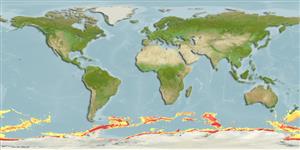Pycnogonida |
Pantopoda |
Nymphonidae
Environment: milieu / climate zone / depth range / distribution range
Ecology
Benthic; depth range 3 - 3227 m (Ref. 1680). Polar
Southwest Pacific and Antarctic: Antarctica, South Orkney, South Shetland and New Zealand.
Length at first maturity / Size / Weight / Age
Maturity: Lm ? range ? - ? cm
Trunk and lateral processes slender. Glabrous. Lateral processes well separated, ocular tubercle and oviger implantations at anterior of first lateral processes. Neck long, abdomen short. Chelifores slender, long, chelae with many crowded teeth. Palps as in N. hiemale. Ovigers very similar in both species but strigilis of this species with more denticulate spines per segment. Legs long, slender, with few short setae. Tarsus slightly shorter than propodus, both with short sole spines only, claw slender, well curved, auxiliary claws about half main claw length (Ref. 9).
Life cycle and mating behavior
Maturity | Reproduction | Spawning | Eggs | Fecundity | Larvae
Members of the class Pycnogonida are gonochoric and sexually dimorphic. During copulation, male usually suspends itself beneath the female. Fertilization occurs as the eggs leave the female's ovigers. Males brood the egg masses until they hatch. Life cycle: Eggs hatch into protonymphon larva then to adults.
Child, C.A. 1998. (Ref. 9)
IUCN Red List Status (Ref. 130435)
CITES status (Ref. 108899)
Not Evaluated
Not Evaluated
Threat to humans
Human uses
| FishSource |
Tools
More information
Age/SizeGrowthLength-weightLength-lengthMorphologyLarvaeAbundance
Internet sources
Estimates based on models
Preferred temperature
(Ref.
115969): -1.9 - 1.9, mean 0.4 (based on 1608 cells).
Price category
Unknown.
